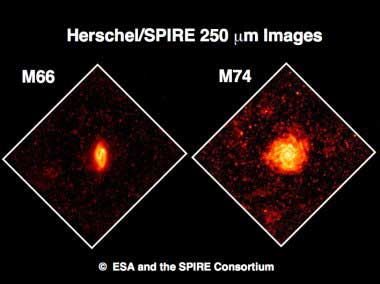Dramatic Images of Galaxies more than 36 million Light Years From Earth
University of Lethbridge-designed technology helps clarify an old question: "What's out there?"
Uploaded with plasq's Skitch!
The European Space Agency released initial images from the Herschel Space Observatory on Friday, July 10, 2009, which capture dramatic and never-before-seen views of galaxies more than 36 million light years from earth.
Key to these clearer pictures of the stars and formations of galaxies is an instrument designed and tested by U of L researcher Dr. David Naylor (Institute for Space Imaging Science, Department of Physics and Astronomy) and a team of students, international colleagues and technicians.
Naylor's instrument, called the Spectral and Photometric Imaging Receiver ("SPIRE"), is one of three devices attached to the Herschel telescope system.
SPIRE picks up heat signals that are not visible by optical telescopes, and will help to answer the age-old question astronomers have been asking for centuries: "What's out there?"
The European Space Agency (ESA) Herschel mission, launched successfully from French Guiana on May 14, 2009 seeks to answer that question by observing stars and galaxies at long-wavelengths (far-infrared).
These wavelengths are able to penetrate interstellar dust, but are difficult to observe from Earth because the far infrared signals can't penetrate the Earth's atmosphere.
As the lead Canadian researcher for the Canadian Space Agency's contribution to the Herschel project – an international project involving eight nations -- Naylor has played a key role in the big science of space imagery by designing a device that has to function at a chilly -270C.
SPIRE collects infrared data from the far end of the light spectrum, and turns it into valuable information about the creation of stars and galaxies – by remote control, and from more than 1.5 million km from earth.
"The mission control operators started the telescope up in stages," Naylor said. "Our instrument was the first brought on-line for performance verification. That means more than 250 tests to put it through its paces. And it is working flawlessly. The last time we had our hands on it was more than two years ago when SPIRE was sent from the UK for final testing and installation at ESA, so that was good news. To process the data to make it operate there are almost 2 billion lines of code involved, so to see a successful operation from this first test was a huge relief."
The next step, which also passed without a hitch, was to pop open the hatch -- officially called a 'cryocover', or the equivalent of a camera lens cap -- and reveal the giant 3.5m telescope mirror to the outer reaches of space.
But does Herschel do what it is supposed to do?
The answer, of course, is yes – and much quicker and with more accuracy than any telescope launched to date.
"Initial images reveal a level of detail never before seen from the ground or from space through the Hubble telescope, which sits only 400km from Earth," Naylor said.
"This isn't even the telescope operating at full capacity. These are initial 'test' images – like driving a racecar very slowly around the track… you know it works and is quite impressive, but wait until the driver opens the throttle!
Naylor sees many unique research collaborations happening in the future, as data from the Herschel mission starts to flow.
"Approximately one-third of the time available to researchers is guaranteed to those involved in key projects, and our time is included in that. We see the data here in Lethbridge before anyone else does," Naylor said.
"This means we will be in the best position to extract the most information from the astronomical data. Scientists will be seeking our help in analyzing their data and the U of L group will be an important Canadian and international resource."
With an estimated output of up to 7,000 hours per year of data, there should be enough information to keep researchers collaborating on current – and future -- projects busy for years.
IMAGES:

Uploaded with plasq's Skitch!
The image of a galaxy named M74, which was discovered by Pierre Méchain in 1780, has previously only been visible as a vague blob of particles and other materials. It is part of the constellation Pisces.
A galaxy named M66, also discovered in 1780 by Charles Messier, has never before been observed so clearly. It is part of the constellation Leo.
The attached images show the differences between previously-available images and the current images from the Herschel Space Observatory.
To view the complete set of images and other information from the European Space Agency, please visit these websites:
http://herschel.esac.esa.int/FirstLight.shtml
http://news.bbc.co.uk/1/hi/sci/tech/8143447.stm
http://herschel.esac.esa.int/SneakPreview.shtml
+++++
BACKGROUND INFORMATION
Getting Excited About Space Research: Meet Dr David Naylor
When you talk to Dr. David Naylor (Institute for Space Imaging Science, Department of Physics and Astronomy), it is easy to get excited about his research, space exploration and the thought of imaging the unknown stars and galaxies that SPIRE, an instrumental concept he has been working on for 30 years will help to discover as it sits, 1.5 million km from Earth, bolted securely to the recently-launched Herschel Space Telescope.
http://www.uleth.ca/notice/display.html?b=300&s=12366
+++++
Made-in-Alberta Technology Goes to Space, May 14
It's not every day that a device and technology created and tested by researchers at the University of Lethbridge gets shot into space and travels more than 1.5 million kilometers from earth to view what might be the origins of star formations and galaxies.
http://www.uleth.ca/notice/display.html?b=300&s=12172
